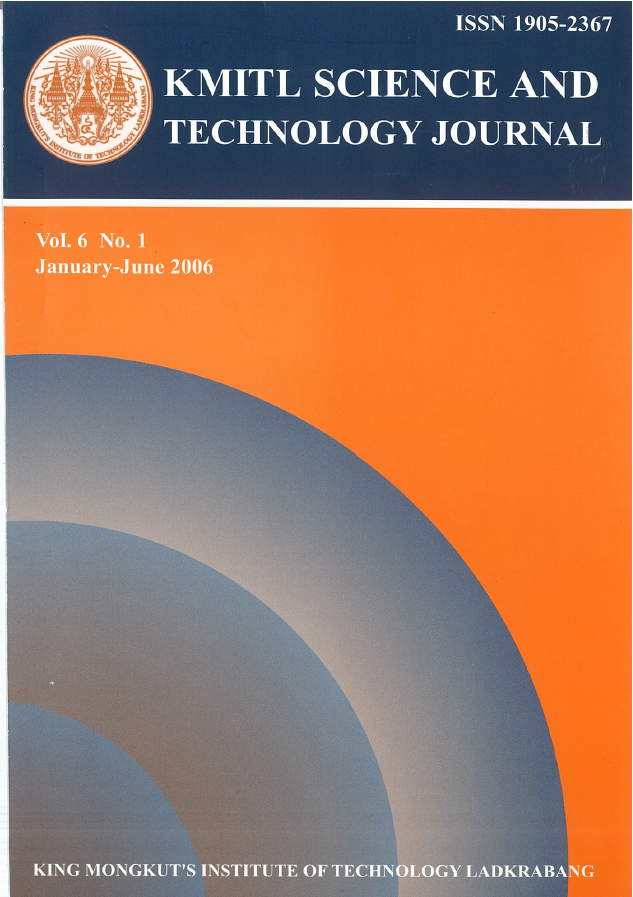Mycotoxins in Animal Feedstuffs of Thailand
Main Article Content
Abstract
Contamination by mycotoxins in human food and animal feed is a worldwide problem because mycotoxins are naturally occurring toxic substances. Human ingestion of mycotoxins mainly occurs from the consumption of mycotoxins in residues and metabolites in animal-derived foods such as milk or meat products. Thailand is in the tropical area, thus it is hard to avoid mold-contaminated food and feed. So, the main purpose of this study was to investigate the possible incidence of mycotoxins in animal feeds. In this study a survey has been carried on the natural occurrence of mycotoxins in commercially available animal feeds. The study was divided into two parts, the first was to identify the genus of molds present in the feed samples, and the second was to determine the mycotoxins in these animal feeds. The results showed that all the samples were contaminated with molds. These molds are Aspergillus spp., Penicilium spp., Fusarium spp., and non-septate fungi. Determination of mycotoxins showed that aflatoxin B1 was detected in 23/25 samples (92%), and the average was 7.56 ppb. Ochratoxin A was detected in 3/10 samples (30%) in levels of 10.48, 11.14 and 12.35 ppb. Deoxynivalenol was detected in 13/15 samples (86%), and the average was 33.77 ppb. T-2 toxin was detected in all samples (10 samples), and the average was 6.91 ppb. Extent of mycotoxins contamination was determined from 10 samples. The results revealed that 3 out of 10 samples were contaminated with 4 mycotoxins (aflatoxin B1, ochratoxin A, deoxynivalenol and T-2 toxin), and 7 out of 10 samples were contaminated with 3 mycotoxins (aflatoxin B1, deoxynivalenol and T-2 toxin). The results obtained in this study suggest a high risk for human health because of the possibility of indirect exposure through meat and other products from animals consuming contaminated feedstuffs.
Keywords: mycotoxins, animal feed
Corresponding author: E-mail: kun99@alpha.tu.ac.th
Article Details
Copyright Transfer Statement
The copyright of this article is transferred to Current Applied Science and Technology journal with effect if and when the article is accepted for publication. The copyright transfer covers the exclusive right to reproduce and distribute the article, including reprints, translations, photographic reproductions, electronic form (offline, online) or any other reproductions of similar nature.
The author warrants that this contribution is original and that he/she has full power to make this grant. The author signs for and accepts responsibility for releasing this material on behalf of any and all co-authors.
Here is the link for download: Copyright transfer form.pdf
References
[2] Smith, J.E., Solomons, G., Lewis, C. and Anderson, J.G. 1995 The Role of Mycotoxins in Human and Animal Nutrition and Health, Natural Toxins, 3, 187-192.
[3] CAST. 1989 Mycotoxins: Economic and Health Risks. Task Force Report No 116. Aimes, IA: Council for Agricultural Science and Technology.
[4] Smith, J.E. and Henderson, R.S. 1991 Mycotoxins and Animal Foods. Boca Raton, F.L: CRC Press Inc.
[5] Smith, J.E., Solomons, G., Lewis, C. and Anderson, J.G. 1994 Mycotoxins in human Nutrition and health. Directorate-General XII, Science, Research and Development, EUR 16048. EN.
[6] Sharma, R.P. 1985 Immunotoxicology of Food Constituents, Food Technology, 39, 94.
[7] Sharma, R.P. 1993 Immunotoxicology of Mycotoxins, Journal of Dairy Science, 76, 892-897.
[8] Bodine, A.B. and Mertens, D.R. 1983 Toxicology, Metabolism and Physiological Effects of Aflatoxin in the Bovine. In Diener, U.L., Asquith, R.L. and Dickens, J.W. Eds. Aflatoxin and Aspergillus flavus in Corn. Alabama, Alabama Ag. Exp. Sta., Auburn University, pp. 46-50.
[9] Guthrie, L.D. 1979 Effects of Aflatoxin in Corn on Production and Reproduction in Dairy Cattle, Journal of Dairy Science, 62, 134.
[10] Smith, J.E. and Moss, M.O. 1985 Mycotoxins: Formation, Analysis and Significance. New York, John Wiley and Sons.
[11] Charoenpornsook, K., Fitzpatrick, J.L. and Smith, J.E. 1998 The Effect of Mycotoxins on the Mitogen Stimulated Proliferation of Bovine Peripheral Blood Mononuclear Cells in vitro, Mycopathologia, 143, 105-111.
[12] Hussein, H.S. and Brasel, J.F. 2001 Toxicology, 167, 101-134.


